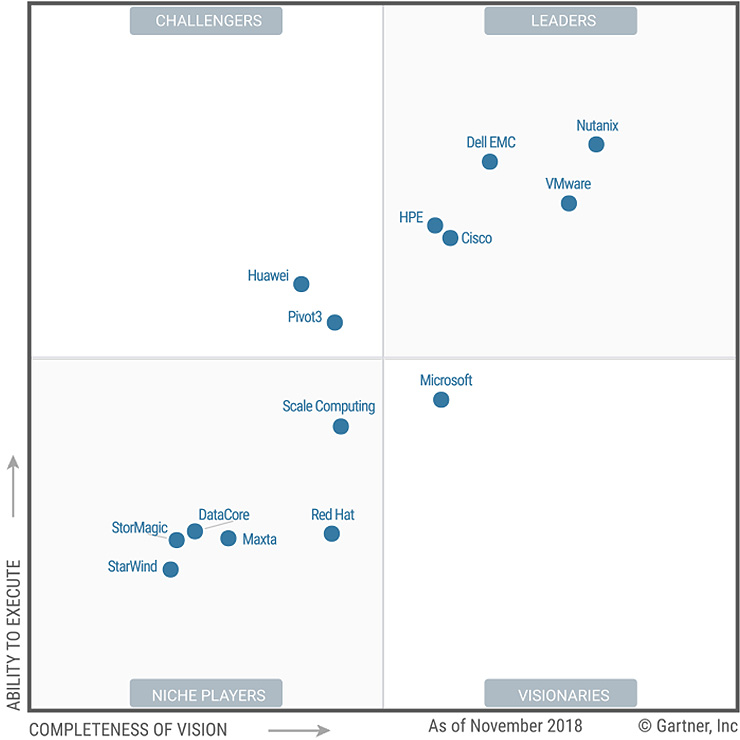
Disclaimer 1: This is a personal blog. Any views or opinions represented in this blog are personal and belong solely to the blog owner and do not represent those of people, institutions or organizations that the owner may or may not be associated with in professional or personal capacity, unless explicitly stated.
Nutanix Xi Frame On-Prem AHV: What Does it Mean to Citrix, VMware and The EUC Community !
The Last HCI: vSAN, VxRail, and Nutanix !
Is Nutanix Doomed ? I Think Not !
Deploy Nutanix Xi Frame AHV On-Premises VDI !
Enhance Nutanix Xi Frame User Experience Domain Settings Optimization On-premises AHV !
Configure Nutanix Xi Frame Enterprise Profiles For VDI On AHV
Is Nutanix Cheaper than Dell EMC VxRail !?
Gartner has just released its first Hyper Converged Infrastructure (HCI) magic quadrant as of January 2018 and unsurprisingly Nutanix is leading the way. Dell EMC is lurking right at the corner just barely behind Nutanix while VMware is 3rd on the leaders board followed by HP (Simplivity) and I believe Cisco (SpringPath) to be 4th from an overall offering perspective.
Having read the report thoroughly and being involved in the HCI world almost from the beginning, I find that the report holds merit and is technically genuine. The Pros and Cons raised are straight to the point and valid in my humble opinion never the less a bit lacking in terms of HCI surrounding echo system of products such as SDN, Hypervisor, Operations, Monitoring, Cloud, and DR.

The aim of this post is not to technically evaluate both solutions nor to compare offerings but rather to guide potential prospects such as partners and to some extent vendors on how to win with Dell EMC VxRail over Nutanix at customer HCI engagements not only from a technology perspective but also overall engagement strategy.
“If you know the enemy and know yourself, you need not fear the result of a hundred battles.” (Sun Tzu)
First and Foremost realizing that the benefit and success of your customer is the ultimate goal, it is imperative that we really believe that VxRail in VMware environments is a better fit than Nutanix which I honestly do, not only from a pure technical perspective but from an overall offering as well. An important note here is that we DON’T care how much IOPS is provided or how many services are supported or what features are added UNLESS it maps to our customer requirements and this is key. 1 Million IOPS on a single VM on AHV with 100% read is definitely cool but does it map to a customer requirement, 99.9% of the times, NO it does not so end of story.
When starting any conversation with customers make sure to state that many vendors have many differentiating features which is a fact never the less what really matters is what is relevant to your environment, requirements, and needs.
There is no denying the level of politics involved when approaching Nutanix and VMware relationship though many choose to deny it and beat around the bush. Dell EMC sells VxRail powered by vSAN and Dell XC powered by Nutanix so product alignment for Dell EMC sales is an interesting predicament.
Dell EMC VxRail offering is based on VMware VSAN which is from an HCI Software Defined Storage perspective a rival to Nutanix AOS, both of which are the brains of the whole operation. The reason we compare VxRail with Nutanix offering not VSAN, is that VSAN alone or VSAN Ready Nodes as well do not provide the end to end SDS solution customers look for in HCI unified offerings such as Automation/Orchestration/Support/Self Service ex: VxRail Manager and Prism among others.
Needless to say that Nutanix consumerized the HCI SDS market and are clear leaders in that area, failure to admit that is a lost battle, thus making our aim just a bit harder. Fortunately most partners driven by Nutanix based on this fact are a bit aggressive and tend to undermine competition which will always come to our advantage. By all means this does not mean it is a lost war, on the contrary, it makes the win just that more enjoyable.
“One may know how to conquer without being able to do it. ” (Sun Tzu)
I will list major points projected by Nutanix to partners and customers alike in an effort to rebuttal widely used arguments while detailing much needed customer facing skills to expose them
“If your opponent is of choleric temper, seek to irritate him. Pretend to be weak, that he may grow arrogant.” (Sun Tzu):
Listen, Listen, and Listen:

“The art of effective listening is essential to clear communication, and clear communication is necessary to management success” (J Penney).
Listen to your customer, listen again, and keep listening, never interrupt them until they finish and I mean absolutely finish. If you begin speaking you have lost the battle, it is imperative that you understand problems, issues, and challenges faced before starting to ramble on solutions. I always assume I came right after a competing vendor (Nutanix) were the customer is already sold thus my only way in is making customers feel listened to, understood, and comfortable.
You might hear false statements about your product, exaggerated facts about your competition, and plain weird requirements, the trick is not to respond and node with a genuine smile until your customer has completely finished talking while taking comments on every point raised especially technical ones.
Expect to hear Vendor-Lockdown, v-Taxation, Data locality, hybrid Erasure Coding, File/Block Services and a whole bunch of Nutanix specific points which we will tackle in a sec once it is clear that listening is a huge part of the overall strategy on an Nutanix convinced potential customer.
“In the midst of chaos, there is also opportunity.” (Sun Tzu)
Acknowledge, Acknowledge, and Acknowledge:

“It is the peculiar and perpetual error of the human understanding to be more moved and excited by affirmatives than negatives.” (Francis Bacon)
Listening part is over and its time to talk right, pause for a second to read your notes, and start re-affirming whatever has been said, like it or not it is just how the human mind works. For some reason 99% of us tend to believe, hold on, and defend whatever we heard first at least to some extent and we never want to proved wrong in a direct way.
Affirm and Re-Affirm whatever has been said even more agree and provide points to prove the customer perception on whatever has been discussed. It is this disruption that is going to gain the attention and trust of your customer thus allowing you to be credible in whatever is to be discussed later on.
“Engage people with what they expect; it is what they are able to discern and confirms their projections. It settles them into predictable patterns of response, occupying their minds while you wait for the extraordinary moment — that which they cannot anticipate.” (Sun Tzu)
But, But, and But:

After trust has been gained and genuinity has been established, it is time for the “but” statement BUT be very careful in what comes out of your mouth after the word BUT. It should not contradict with statements acknowledged or re-affirmed, the whole purpose of the word but here is to incite suspicion and stimulate curiosity.
Fortunately Nutanix partners are very aggressive and mostly not aware of their competition except what they read in Nutanix provided battle cards which to us is of great advantage. Outdated and misunderstood information relayed to customers especially VMware customers (our only targets) on VxRail and VSAN from Nutanix partners is always a welcome opportunity to discredit and prove wrong, this always leads to mistrust on behalf of the customer that projects to everything relayed on Nutanix technology.
“Knowing the enemy enables you to take the offensive, knowing yourself enables you to stand on the defensive.” (Sun Tzu).
Be careful when going up against Nutanix employees however because most of them are X VMware, v-Experts, or VCDX holders so they are technically very qualified never the less it is this commercial world we live in that would prevent them from saying the whole truth and trigger them into stating cliché statements about their competitors.
“When the officers are too strong and the common soldiers too weak, the result is COLLAPSE.” (Sun Tzu)
Discrediting one single point that is wrong or misleading (Effective listening is vital in catching information which almost certainly have been said by opposing partners however insignificant it might sound) automatically puts customers in listening mode and tends to undo whatever has been said on Nutanix and VxRail from opposing parties.
Now that general approach has been laid down, remember not to fall into the same pit hall, do your work intensively, know both technologies, prepare very carefully, listen to your customer and map problems to technical solutions, pitch the story not the product, know your shit and never ever attack opposing vendors (Listen, Understand, Affirm, Acknowledge, then Rebuttal) .
“It is the rule in war, if ten times the enemy’s strength, surround them; if five times, attack them; if double, be able to divide them; if equal, engage them; if fewer, defend against them; if weaker, be able to avoid them.”(Sun Tzu)
Vendor Lock-Down:

By far the most over-used term by Nutanix sales is vendor lockdown by which they mean with VxRail only VMware vSphere hypervisor is supported while Nutanix supports AHV, vSphere, Hyper-V, and XenServer.
Lets start by stating that VxRail is a joint offering between Dell EMC and VMware aimed at current or potential VMware customers as VSAN is an kernel embedded solution which obviously can only be supported on vSphere. IF customers want another hypervisor simply enough proposing VxRail is not an option rather Dell XC powered by Nutanix would be the obvious choice. If the customer is sold on a different hypervisor, there is simply no competition to begin with as VxRail is architectured for VMware vSphere.
Now choosing a hypervisor to begin with or wanting to change a hypervisor in the future is not a decision to be taken slightly. The amount of technical effort and risk involved is huge and must be well thought through not only within the IT department but extends to different application and business teams. It is a fact that most customers use and are comfortable with vSphere thus are potential customers for VSAN and subsequently VxRail. Needless to say Nutanix first supported hypervisor was vSphere and biggest install base is vSphere … !
Case 1: Customer wants to continue with vSphere while transitioning to HCI is best candidate for VxRail. VSAN is an kernel embedded feature that is developed, supported, maintained, and updated by VMware so I am assuming they can better integrate with their own hypervisor. The only pitch here for Nutanix is price and will get back to that in a moment.
Case 2: Customer has VMware but is open to new hypervisors while transitioning to HCI. This will highly depend on the workloads running in the environment and their criticality. Many customers don’t like Hyper-V or XenServer for reasons I wont discuss here mainly too many patches and updates specifically for Microsoft Hyper-V while Nutanix Acropolis AHV until now is not officially supported by a wide range or business critical applications and is relatively a brand new hypervisor built on KVM. A simple statement like “Do you really want to run your LOB and business critical applications on a new hypervisor” is 99% of the time enough, don’t go into features not supported by AHV or are being developed, there is no need for that as of now, maybe in couple of years but for now stick to that simple statement which is by the way TRUE.
vSphere is the only guaranteed stable supported hypervisor that can run most workloads out there and everyone knows it. Based on the assessment of current workloads and requirements, it can be highlighted whether advantages of moving to a new hypervisor outweigh disadvantages considering technical risk and financial impact, most of the time the risk is not worth taking but again this all depends on customer requirements, use case, and workloads.
Case 3: Customer wants to change hypervisors and doesn’t want to be locked into vSphere alone. We have two scenarios here, if the customer wants to change hypervisor now while transitioning to HCI then simply enough VxRail is NOT an option. If the customer wants the option of changing hypervisors in the future ( Here is where Nutanix pitch excels ![]() ) then yes VxRail is still a good fit.
) then yes VxRail is still a good fit.
Asking your customer when do you plan on changing your hypervisor would span up an answer directly from Nutanix representatives, “I may want to change at Anytime”. That statement is 100% false as its not realistic nor feasible in most cases. Changing an hypervisor after just purchasing and implementing a different one would require extensive planning and execution to say the least, support and compatibility of workloads alone is a nightmare let alone the risks involved, not only that but think of the technical impact of such a change from an execution perspective as well as skills matrix at your customer.
What about if customers have a single cluster with no enough space to re-image their appliance with a new hypervisor or a big cluster with RAID 5/6, should we assume that Nutanix will provide the same to accommodate the change and own the risk of doing so to production environments !? I haven’t seen environments with N + N high availability to accommodate a full production hypervisor change on the same hardware within its lifecycle. This does not apply to all environments, since clusters can be big enough for the same or have another infrastructure to accommodate the migration.
This keeps VxRail in the game because when customers understand that Hypervisor changes must be planned and executed extensively, it cannot be done on the same hardware that was purchased with a different hypervisor from the start or to be specific, is not as easy as Nutanix pitch it to be. If purchasing the new hypervisor on the new hardware then VxRail is not an option, we are talking here on Hypervisor change pitch done by Nutanix to vSphere customers which is the least to say misleading and incomplete.
Nutanix Challenge: Make your point valid and tell us how many Nutanix customers changed from vSphere to another hypervisor on the same hardware within the hardware life-cycle for that company !? I doubt it to be more than 1% …
“Begin by seizing something which your opponent holds dear; then he will be amenable to your will.” (Sun Tzu)
vTaxation:

This is a term invented by Nutanix (Not Officially) to screw VMware by misleading customers into believing that VMware licenses are so costly that they are considered taxes rather than paying for services because alternate solutions may provide the same service with a significantly lower cost.
Lets start by the obvious shall we, Nutanix is NOT free, AHV is NOT free, and Prism is NOT free. Many don’t realize that Nutanix has a software model and license based on Starter, Pro, and Ultimate which are different in price and offer different set of features. Nutanix mask that by embedding this into their BOQ without most of the time informing customers about it so its practically invisible (Good Sales Strategy).
Nutanix does not offer independent AHV hypervisor sales thus as of now we cannot determine how much they would charge for their hypervisor if that would be the case. The cost you are paying for AHV and Prism is embedded in the Nutanix SDS license/hardware sold by them so claiming it to be free is far from the truth.
VMware started and led the hypervisor business in the same sense as Nutanix did with HCI but if we apply the same vTaxation terms on Nutanix we can claim that Nutanix is vTaxing you for software defined storage solutions while VxRail provides VSAN enterprise embedded license for free. We both know VSAN license is NOT FREE but it is embedded within the offering, same applies to Nutanix and AHV hypervisor so Nutanix stop this nonsense of a statement … Nothing is free !
“All warfare is based on deception” (Sun Tzu)
vNuts Licensing:

VMware Enterprise Plus licensing is not cheap at all but do we actually need it with VxRail !?
VxRail bundle includes vSAN enterprise and vCenter standard licensing but does not include vSphere, well it use to, until some genius decided it was not anymore, which believe me proved to be a reckless decision but that’s that. I almost guarantee you if, as we stand today, vSphere standard was still part of the bundle, Nutanix would hardly win over an already or potential VMware customer looking for HCI.
vDs and DRS are only supported with vSphere enterprise plus thus many customers choose to go with enterprise plus licensing rather than the much cheaper standard licensing. Yes, other features such as FT also required enterprise plus but from what I have seen in the market, vDs is a must have and other features like DRS/FT are to some extend expansible.
Well vSAN Enterprise by default includes vDs even when using vSphere standard so with VxRail if you buy vSphere standard, you still get Distributed Switch functionality with no additional cost since its part of the bundled provided vSAN enterprise license.
DRS is important especially for automated upgrades but not critical to many environments depending on workloads and administration teams, an example would be a VDI environment with non-persistent virtual desktops or servers, DRS would never be utilized or used, and the same applies to other scenarios.
More so, a new feature that will be introduced in the next VxRail release, will make upgrading VxRail with standard license a breeze without the limitations of NO DRS in standard mode (NDA as well but you get the point) which would make DRS use-cases even less and standard licensing a very attractive bundle for so many use cases and potential customers so stay tuned.
This makes VxRail an attractive offering since vSphere standard price wise is very cheap and affordable in terms of added value given that it is vSphere 🙂 and support renewal is much cheaper as well, which makes Nutanix licensing look like vNuts ? .
“Give me six hours to chop down a tree and I will spend the first four sharpening the axe.”(Lincoln)
Data Locality vs Distributed RAID:

A long endless debate in the HCI world exists between Distributed RAID and Data Locality architectures mainly between VMware VSAN and Nutanix. In essence each vendor twists the technology advantages/disadvantages to there own benefit (which makes sense from vendor perspective), Nutanix Data locality does not heavily depend on the network since a local copy of the data is always served from the same node a VM is hosted on until a failure occurs in which the VM started on other node reading from the network until a new local data copy is built on the new node on top of read I/O should have low latency since its not leaving the node itself while VMware VSAN distributed RAID relies heavily on the network since no locality exists except in a stretched cluster scenario and a VM is spread on different nodes reading from different disks.
Nutanix Data locality consideration is mainly with DRS and to some extent maintenance mode, imagine only imagine DRS is invoked every 10 minutes and you have a cluster with 1000 VMs and 20 servers , the impact of moving say 10% of the VMs constantly using DRS fully automated on performance is huge as the data has to always follow the VM and until it has created a local copy its reading from the network. On the upside, just like In-Kernel vs. VSA, reading/writing locally while not traversing the network would for sure be at some level faster than network but as stated these differences do not effect 99% of workloads thus irrelevant to many customers. More so, lets be realistic, where would you have this kind of DRS setup !? so to me, it is not a limitation but just a consideration.
VMware VSAN distributed RAID consideration is mainly with network, VMs read from different hosts/disks at all times ( except if the data happens to be on the same node or in cache ) and all traffic is traveling through the network so that is major utilization of network resources and reliance, another issue that is being propagated in the market is that SSD/NVMe speed is getting higher than 10GB networks throughput can handle in a distributed RAID configuration thus very soon with NVMe, IO throughput on the network will require more throughput than a 10g network can handle so that would incur latency and reduced performance/speed.
We need to free ourselves from these cliche generic statements and actually concentrate on what related to us in terms of needs, requirements, and vision.
“In giving freedom to the slave, we assure freedom to the free”(Lincoln)
The funny thing here is that Nutanix representatives fail to mention that a network loss obviously means inaccessibility for all your workloads regardless of the status of your SDS provided whomever that may be. The loss of switches connected to VxRail or Nutanix regardless of technology would render the cluster useless, so this is only addressing network throughput on L2 or L3 switches used not availability, also note that 25GB networks are becoming standard now ( actually they are and VxRail supports it ) and will eventually be server standard assuming NVMe will be cheap enough to use for most customers.
Why Nutanix try to dazzle customers with Data Locality is out of my comprehension, from a customer perspective, NO tangible verified data has shown that limitation or advantages of each approach effect customer requirements and environments in 99% of the use cases. Both approaches have thousands of customers with hundreds of thousands of workloads without impact on how data is handled.
Nutanix Challenge: Make your point valid and show us verified data that 10GB networks with current VxRail available models/disks/NICs have throughput issues or limitations when using vSAN for well known workloads that would map to 99% of customer requirements in general !?
“Those skilled at making the enemy move do so by creating a situation to which he must conform; they entice him with something he is certain to take, and with lures of ostensible profit they await him in strength.” (Sun Tzu)
In-Kernel vs VSA:

In the same way Nutanix projects Data locality as a key differentiator in how data is superiorly handled on their platform, VMware states that In-Kernel SDS functionality provided a faster IO path than Virtual Storage Appliance architecture.
In a nutshell, vSphere has vSAN code embedded into the kernel so all data IO is processed at the kernel level of vSphere while with Nutanix a Controller VM has to run on every host in order to handle data IO. Both of these approaches incur overhead that being in-kernel or CVM so that is not a valid argument for VxRail/vSAN though vSAN does take less CPU/RAM yet the point here is that running in-kernel at some level will always be faster.
The statement is true not only from an IO path perspective but also from an high availability perspective. Obviously IO processed in the kernel is faster to some extent than IO processed through a virtual machine no matter the technology used but I have to say here that NO tangible verified data has shown that this impacted 99% of customer use cases. Does this macro or micro different in processing IO effect customer workloads ? I would have to say no.
Being honest and open is key for technical personnel and I find it to be in the core of real professionals. List the advantage of In-Kernel just like Nutanix pitch Data Locality but be very open about the fact that both technologies work and that IO latency introduced by VSA does not effect most workloads and is invisible to customers.
“Honest differences are often a healthy sign of progress.” (Gandhi)
Deduplication, Compression, & Erasure Coding:

All three are supported by Nutanix on All-Flash and on Hybrid appliances while on VxRail/VSAN only All-Flash appliances support Dedup, Compression, and Erasure Coding.
Though these features are supported on Nutanix never the less they do NOT come enabled by default on hybrid appliances and Nutanix does not recommend enabling deduplication on hybrid nodes or erasure coding for that matter especially with workloads that require intensive writes like VDI . The overhead produced for the same does not make sense on hybrid nodes in terms of CPU, RAM , and Disk. Erasure Coding makes sense with big clusters though and its a nice feature to have available in hybrid appliances for some use cases where usable disk is more important than performance.
To my knowledge, VMware is not working on supporting these features on hybrid appliances, only for the fact that sales on hybrid is dropping fast and as SSD prices become cheaper, the defacto standard for HCI is All-Flash appliances. Forget about dedup/compression ratio projected by Nutanix or by VMware, it all depends on the type of data being stored and both cannot guarantee the same.
Always lead with All-Flash appliances when competing against Nutanix to avoid explaining why these features are not supported on hybrid and why any customer should NOT go for hybrid anymore.
“These military devices, leading to victory, must not be divulged beforehand.” ( Sun Tzu )
vSAN Disk Caching Limitation !?

The action of manipulating something in a skillful manner is the dictionary definition of manipulation, something that sales-oriented architects tend to be very good at. Don’t get me wrong, manipulation is not always a bad thing, it’s almost always about context.
On a personal note, aside from IT related matters, everything in life is about context. The consequences of words or actions can drastically change based on context and realizing this early on makes all the difference. Strive to understand the full picture and context of any action or statement before judging in order to be truthfully objective.
That been said, a statement that you would almost always here from a Nutanix representative, is vSAN and consequently VxRaiL has a write cache disk limitation of 600GB. To clear this up in a readable manner, I will just state pointers:
-
- vSAN Hybrid does NOT have any capacity or write buffer limitations for cache disks.
-
- vSAN All-Flash does NOT have any capacity cache disk limitations meaning SSD Cache disk can be any size rather it has an internal write buffer limit of 600GB.
-
- vSAN All-Flash with Cache disks above 600Gb will use the remaining capacity for endurance so it will not go to waste or stay unused. Endurance will increase the disk life span and enhance performance predictability.
-
- vSAN works using disk groups and each disk group must have a write cache disk. In All-Flash vSAN, the write cache disk is used for 100% write thus all reads are processed by SSD capacity disks in disk group.
-
- The difference between a caching disk and a capacity disk in an All-Flash VxRail is that the caching disk normally has 10dwpd 10 writes per day while the capacity disk has 1dwpd 1 write per day. Both are still Solid-State Disks but caching disks handle writes better than capacity disk so all “hot” writes hit the caching disk first and then offload to capacity disks.
- vSAN All-Flash recommended ratio is 10% Caching from total disk group size, which will handle only pure writes.
Based on VMware/Dell EMC extensive testing and architecture validation, pure write cache disks operate at an optimal level with 600GB for writes only never the less when going above that limit, durability of caching SSD start to get impacted. The 600GB write cache buffer is set to make sure that your caching disks operate in an optimal manner in terms of performance and durability.
VxRaiL E-Series which is “Enterprise” not “Entry” as Nutanix tend to project to customers (its Dell EMC fault as they actually named it entry for sales purposes …) can accommodate 2 disk groups each will have a dedicated 800GB or 400GB caching disk. This fits the 10% ratio recommended for most workloads and used on VxRaiL All-Flash.
VMware just recently released a blog confirming that the 10% cache to capacity ratio does NOT apply to All-Flash deployments:
“vSAN All Flash cache and capacity ratio: There is some confusion today that the 10% vSAN cache to capacity ratio needs to remain the same for an All Flash vSAN. This 10% guideline was meant for hybrid vSAN only. This 10% is a general recommendation could be too much or it may not be enough and should be based on use case, capacity and performance requirements. vSAN all flash caching does not have a % to capacity ratio requirement.”
“Strategy without tactics is the slowest route to victory. Tactics without strategy is the noise before defeat.” (Sun Tzu)
vSAN Disk Failure !?

OH MY GOD, if a disk group caching disk fails, the whole disk group fails, you are ruined, ruined, ruined I tell you !
True, if a caching disk fails, the whole disk group stops working until that cache disk is restored or changed, that is how vSAN works and that is why we have multiple disk groups per server or appliance and we always have N + 1 High Availability at least. Failures happen, that is part of life, and part of why we have an IT job. The caching disk in a high endurance enterprise SSD and VxRaiL Manager is always assesing the performance and health of this disk to notify you if it requires any change but then again yes everything is prone to failure including yours truly, Nutanix AOS …
Now look at Nutanix for instance, AOS operates on virtual machine just to put it in simple terms and when using vSphere also has some internal host network built, so lets assume for the sake of argument, I as a lay-man admin, turn off this VM or change anything on this VM or choose to delete that network from the host or this VM just crashes, what would be the impact !? if you guessed total failure specifically when messing with those networks then you guessed right, well in-case of AOS CVM going down, VMs start reading from other CVMs in the cluster over the network ( so just like distributed RAID mmmm ) !
Each product has its architecture and subsequently limitations, both have operations in place at some level to deal with those limitations so why Nutanix representatives choose to promote these statements is out of my comprehension. So the next time, someone tells you about a caching disk failure effect, you just ask about an AOS failure effect. Software is more prone to failure than hardware … !
“Respond intelligently even to unintelligent treatment” (Sun Tzu)
Block & File Services:

Nutanix Acropolis File Services offers SMB CIFS highly available file shares that integrate with Active Directory and offers block services as well in terms of target ISCSI disks that can be presented to virtual machines.
VSAN 6.6 which is part of VxRail 4.5 latest release supports ISCSI target for Oracle workloads and physical hosts. It does not as of now support presenting ISCSI disks to virtual machines and Microsoft Failover in-guest clusters. VMware are working on supporting Microsoft Failover Clusters and presenting ISCSI disks to virtual machines which is supposed to be released with official support this year.
Again this depends on use cases and does not apply to all customers. If they don’t want to invest in Exchange DAG, DFS-R, and/or SQL AlwaysOn for licensing purposes , we can as of now use Server 2016 or 2012 R2 virtual machines with ISCSI target feature enabled to present shared storage to virtual machines. Host HA for that ISCSI target machine is maintained by VMware HA while Fault Tolerance (Enterprise Plus Feature) to ensure zero downtime on shared storage.
Yes This is a workaround for now and not the solution since VMware FT would still not provide service HA for ISCSI target VM. Very Very Very soon when VSAN ISCSI supports Microsoft Failover Cluster and VMs , that would be the end of block storage sharing limitations on VxRail. Since DFS-R takes double the storage, creating a guest file server cluster using ISCSI disks presented from VSAN would solve file services as well ( The only difference here is we built the file service ( 30 min task with PS ) while Nutanix automated it with same end result.
“Swift as the wind. Quiet as the forest. Conquer like the fire. Steady as the mountain” (Sun Tzu)
Update: vSphere 6.7, vCenter 6.7, and vSAN 6.7 have just been released with support for Microsoft Windows Failover Clustering and Virtual Machines iSCSI shared disks which enables sharing block storage for in-guest clustering and building file services using a Windows Server File Failover Cluster. Dell EMC VxRail will support vSAN 6.7 with the release of update 1 . Nutanix better update their Sales/Technical battle cards and Partner as soon as possible 🙂 .
From a technical perspective, we now have the ability to support highly available File Servers and SQL servers that required a Microsoft Failover cluster which in turn requires shared storage. DFS-R and AlwaysOn are not an option to many customers because of mainly licensing concerns when it comes to SQL and storage capacity requirements when it comes to DFS-R so supporting a Failover Cluster on the same vSAN cluster that is hosting those VMs mitigates those concerns when transitioning to VMware HCI.
From a business perspective, Dell EMC VxRail and VMware VSAN ready nodes, both of which are powered by VMware VSAN for SDS functionality, do not have built-in File and Block storage services when it comes to their HCI offering. Nutanix on the other hand with Acropolis File Services, supported this for some time now which gave them a clear advantage with SMB customers that cannot afford alternatives or are looking to fully transition to HCI without the need of other SAN/NAS devices.
When Dell EMC VxRail releases the upgrade package for 6.7 which should be around the time VMware releases 6.7 update 1 ( 90% customers wait for update 1 anyhow ), Block file services would be officially available and supported on VxRail thus putting this side of Nutanix story to bed. File storage services on the other hand will YES be available BUT with a minor difference, you as a customer would have to build and manage those File Servers based on an File Server Failover Cluster that being CIFS or use another technology for NFS.
The point here, and I have relayed this to Dell EMC recently, is that Nutanix just automated the creation of those services and eased up the management of those file services from Prism yet the result and backend setup is the same, as if you manually presented iSCSI disks and created an HA FCI File Server then managed it. Creating iSCSI shared disks is very easy with vCenter HTML5 and thus I want Dell EMC and VMware to just automate the File Services part (Orchestrator and only give us CIFS no need for NFS for now) and embedded into vSAN or VxRail Manager ( some surprises coming soon ![]() ) to put the mgmt. side of File Services with Nutanix to bed as well.
) to put the mgmt. side of File Services with Nutanix to bed as well.
Configure VMware vSAN 6.7 iSCSI Target for Windows Server Failover Cluster File Server & SQL
“Never interfere with your enemy when he is making a mistake.” (Sun Tzu)
Prism vs. VxRail Manager !?:

“I Taut I Taw a Puddy-Tat “.
If you are thinking that VxRail Manager does not stand a chance against Prism then your are absolutely right , because simply enough the comparison analogy is flawed. Prism should be compared to vCenter and VxRail manager all together not separately.
Truth being told, Prism is an administrator’s dream as it makes management as easy as a click of a button, and groups important tabs that would be used by an administrator for 90% of the time into a single HTML5 platform/view/console. Nutanix did a much better job than Dell EMC or VMware when it comes to making life easier for IT daily tasks and for that they deserve to be acknowledged.
VMware and Dell EMC were very slow in terms of actually unifying VxRail under a single management platform after VMware EvoRail and EMC VSPEX blue were combined into Dell EMC VxRail. We have VxRail manager as of now which handles the initial deployment of a VxRail Cluster that includes automatic configuration of all components (vCenter, PSC, vSphere, DataCenter, Cluster, DRS, vMotion, Networking …) on top of maintaining the health and support of the VxRail system ( Upgrade, Update, Patching, Adding nodes, Adding disks, Replacing disks, Support ) while VMware vCenter web is used for hypervisor/Cluster/VM related management activities.
The fact that Prism combined both (Only AHV includes every possible management option while Nutanix with vSphere still required vCenter management activities) and VxRail/vCenter has not, does not mean that Prism would only be compared with VxRail Manager, but rather Dell EMC/VMware need to put in the effort to unify the portal so that a clear comparison can be made and the right analogy is used. Note that VxRail Manager is not used on a regular basis so this is not a show stopper by any means but again we want a unified end-to-end product.
With vSphere 6.7 all of this has changed and with vCenter/vSphere 6.7 u1 release ( VxRail major releases are aligned with u1 ), something extra-ordinary is going to happen (NDA …) that is going to make whatever I have mentioned above irrelevant, so you can guess where I am going with this without having to actually say it. VxRail will be a unified management platform and for a VMware administrator, nothing new has to be learned or used 😉 all from a complete HTML5 console that everyone is used to, aware of, and incorporates the whole HCI environment with as much clusters as you want :). Wait for this close to Sept/Oct hopefully.
To sum this up, following Nutanix points are going to be rendered utterly useless:
- Prism is a unified console while VxRail Manager and vCenter are not !
- VxRail Manager can handle a single cluster.
- Prism can automatically configure physical switches.
- Prism is completely HTML5
- Prism is a superior management platform than VxRail Manager ( we established that is a wrong comparison analogy and with coming changes no comparison can be made ).
- Prism includes Analytics, Operations, and central management ( Prism Central ).
Mark my words, Dell EMC VxRail is going to be much more than that in the very near future and the good thing is that at last the good folks handling VxRail are starting to listen to market feedback and act fast in accordance with VMware.
Nutanix obviously has a very high rate of technological advancement so they will also keep improving, there is not much more from an pure HCI technical perspective that can be done thus their obvious shift to cloud, Analytics, Operations, Availability, and Security.
As VMware has far more superior and mature products in those areas ( stop trying to compare as of now maybe in couple of years, can you imagine comparing Nutanix Flow to VMware NSX or NSX-T !? or Nutanix LCM to VMware vRealize Automation !? keep calm and be realistic ), by the time Nutanix catches up, Dell EMC and VMware have a golden opportunity to close the gap in their HCI offering and provide an end-to-end unified solution that would not be comparable with its suite of products and integration to Nutanix or any other vendor in the market.
“Be extremely subtle, even to the point of formlessness. Be extremely mysterious, even to the point of soundlessness. Thereby you can be the director of the opponent’s fate.” (Sun Tzu)
Price:

Unfortunately I cannot list prices on Nutanix and VxRail for obvious reasons but I can state simply that based on my experience working with both that an VxRail All-Flash is always cheaper than a Nutanix All-Flash in term of list price even when vSphere prices are added.
Nutanix tries to play on the yearly support you have to pay VMware to present an ROI/TCO that makes sense never the less this price difference in support is most of the time an side factor knowing that most Nutanix sales are based on vSphere so that still applies …
With the right sizing and aggressive discount, almost always, VxRail will beat Nutanix when it comes down to price even when vSphere license is added to BOQ as part of the overall offering especially with standard pricing.
Is Nutanix Cheaper than Dell EMC VxRail VMware vSAN HCI !?
“For the wise man delights in establishing his merit, the brave man likes to show his courage in action, the covetous man is quick at seizing advantages, and the stupid man has no fear of death.” (Sun Tzu)
Number ONE (King) HCI Vendor !?:

“Kings are not born: they are made by artificial hallucination”(George Bernard Shaw)
Ever since IDC report for Q2 2017 on HCI stated that Dell EMC/ VMware have the biggest market share and Gartner report in Jan 2018 stated that Nutanix are leading the magic quadrant on HCI, both vendors have been claiming and marketing that they are number one in Hyper-Converged Infrastructure.
To clear this, lets state the obvious, in order for any company to claim officially that they are number one in HCI in terms of market share, we need official sales reports from each company on the total number of sales overall and we have to assume that these reports are valid/accurate. From this perspective vSAN has around 14,000 customers and Nutanix have around 9,690 customers as per their Third Quarter Fiscal 2018 Financial Results.
YET, this does not mean that VMware is number one in HCI market share because sales alone is not enough to determine that. vSAN comes as part of many different VMware licensing such as Horizon so the problem is here is that we cannot guarantee that all sold VMware vSAN HCI licenses are actually deployed. Nutanix on the other hand is different, every sold Nutanix license is surely deployed.
So both CANNOT claim that they own the biggest market share in HCI or are number one in this area (Kings or otherwise …) until both companies release official statements on how many of these sold licenses are actually being used. VxRail has around 3500 customers so the majority of VMware HCI numbers are coming from VSAN which is not sold independently to guarantee it is actually deployed.
That been said and this is my personal opinion, I believe that Nutanix in terms of deployed HCI in the market, have a higher number than Dell EMC / VMware . I would say that Dell EMC/VMware are number on in HCI software sales and Nutanix are number one in Deployed HCI software but both are not KINGS … !
“He who knows when he can fight and when he cannot, will be victorious.”(Sun Tzu)
Which is Better !?

As a customer, partner, or vendor, you need to resist the urge of asking “either this or that” questions not only because they are illogical and unfounded but because they almost always lead to disaster and this applies to everything in life. Your brain wants an easy way out and thus limits your options which in turn limits your ability to have an open mind set on the right question to ask.
The right question would be, which product/technology fits my requirements, solves my challenges, and satisfies my needs. This is what matters and any judging criteria should always be tailored to your requirements and not generic reports or vendor battle cards.
If you find a Nutanix, VMware, or Dell EMC representative starting an HCI conversation by showing you slides on the difference between In-Kernel vs VSA or Distributed RAID vs Data Locality without actually spending some time understanding your requirements and needs (even then it doesn’t make sense to tackle these points yet), know for sure that they only want to sell and spread FUD without actually understanding why, how, when, and where which are the specifics of you as a customer …! These differences specifically do not effect 99% of customer requirements and should not be discussed except when asked for or a requirement exists that these features would make an actual difference.
That been said, the whole aim of this post, is for us to understand that both Nutanix and VxRail are great technologies, mature products, and have differentiating features that might or might not fit your environment requirements. Why is this post directed to win over Nutanix !? because they actually spread these differences in an aggresive and manipulative way to customers much more than Dell EMC or VMware personnel do.
“The art of war is of vital importance to the State.” (Sun Tzu)
Conclusion:

“I’m not the greatest; I’m the double greatest. Not only do I knock ’em out, I pick the round.” (Muhammad Ali).
I only touched based on major points raised by Nutanix when competing with VxRail at customer engagements. This has proven successful at multiple engagements only because being honest and sincere always pays off no matter the outcome. I am open to any comments and if anything is not precise, rest assured, I would amend accordingly, just let me know your thoughts.
Fanatics that read to respond rather than understand have all of my empathy and I wish them well. Response is always good as long as its objective and founded upon not because an indivisual works for a specific company and feels obliged to respond no matter what. Do not confuse loyality with subjugation ! thus my advise to those indivisuals is “The unexamined life is not worth living” (Socrates).
“Know the enemy and know yourself; in a hundred battles you will never be in peril. When you are ignorant of the enemy, but know yourself, your chances of winning or losing are equal. If ignorant both of your enemy and yourself, you are certain in every battle to be in peril.” (Sun Tzu)
Nutanix Xi Frame On-Prem AHV: What Does it Mean to Citrix, VMware and The EUC Community !
The Last HCI: vSAN, VxRail, and Nutanix !
Is Nutanix Doomed ? I Think Not !
Deploy Nutanix Xi Frame AHV On-Premises VDI !
Enhance Nutanix Xi Frame User Experience Domain Settings Optimization On-premises AHV !
Configure Nutanix Xi Frame Enterprise Profiles For VDI On AHV
Is Nutanix Cheaper than Dell EMC VxRail !?
May the Peace, Mercy, and Blessing of God Be Upon You
“SQL AlwaysOn for licensing purposes”
SQL BAG (Basic Availability Groups) is available in standard MS SQL licensing now FYI. No need to pay for AAG to do application-level failover.
Hi John,
BAG only supports one database per listener so impractical for enterprises where 10`s of databases exist though an option for SMBs . Also SQL 2016 and later is not an option for all customers.
I read it thoroughly and I must say it is one of the best articles I ever read.
Thanks Hesham .
You are a very confused individual.
It was nevertheless entertaining.
Hi Jake,
Glad you found it entertaining 🙂 .
This makes me want to go buy Nutanix.
Hi Darren,
Good Luck, That should depend on your requirements and no doubt about it Nutanix is a great technology.
Your in kernel versus “VSA” (which no longer exists by the way) is way off. In kernel is no faster than a virtual storage controller (CVM) writing via DirectPath I/O which VMware themselves have validated a million IOPS SQL VM using this DirectPath I/O methodology. Also the entire idea of “in kernel” is invalidated when you are reading data across the network anyways as VSAN does; which is inferior to local reads as Nutanix uses. There are also many other differentiators that you miss; especially around what happens when VSAN loses a disk; versus what happens when a Nutanix cluster loses a disk. Rebuild times in VSAN are much much longer than Nutanix’s self healing capabilities and rebuilds with Nutanix happen by the ENTIRE cluster contributing to the rebuild. Too many technical differentiators to list. VSAN is very crude way to virtualize storage whereas Nutanix is an entire platform with many other services.
Though this was not meant to be a pure technical comparison but I will address your statements starting by the last, you do not compare VSAN to Nutanix, you compare VSAN to Nutanix SDS services and compare VMware to Nutanix when you want to discuss other services. Would you really compare Nutanix LifeCycle Management to vRealize Automation, NSX to Nutanix SDN, Prism to vCenter with vRealize Operations, or RP4VM/SRM to AOS Replication !? I don’t think much elaboration is needed when trying to approach other services, there is no room for comparison at least at this stage, maybe in a couple of years, and do not that all are paid services and yes prices vary a lot but don’t pitch free services plz 🙂 … VSAN 6.7 data rebuilds are much faster and resilient with adaptive resync feature that ensures a fair-share of resources are available for VM I/Os and Resync I/Os during dynamic changes in load on the system, an improved vSAN storage scheduler uses congestion signaling to detect both the read and write throughput capabilities of a vSAN disk group. Also from a pure SDS services, Nutanix had an edge with AFS and I noted this but with VSAN 6.7 that has been taken care of and both shared block and file services can be natively built on VSAN though Nutanix makes it easier to do so. If you are referring to a write cache disk failure that would render the disk group in maintenance mode, well I wonder what an CVM failure would do to a node … these type of cliche statements that Nutanix have projected in the market do not work anymore, its just how VSAN works with disk groups/write cache disk and how CVM works with Nutanix, failure of any result in consequences, that is why both need N+1 at least .!? In regards to Data locality/Distributed RAID and In-Kernel/CVM , the whole point I am making is that differences in all do not effect 99% of customer user cases and both have thousands of workloads running with no performance impact so both do not have valid arguments, I don’t care if AHV can get a billion IOPS read write 64K blocks on a single VM since this will never map to a customer requirements or a realistic real world use case. I guess next your going to mention 600GB VSAN All-Flash write cache disk limitation :), let me know and we will discuss that as well when Nutanix shows us a workload on all flash that would require more than 600GB pure write caching on a 10wpd disk rather than a 1wpd knowing that VSAN hybrid doesn’t have that limitation because the write cache is used for reads and writes which would only prove that technically speaking they can support it on All Flash as well if that was a real use case.
Things are much more clear now.
Thank you.
Thank you for reading and most welcome.
Fair enough ..
Great efforts, I’m also preparing NPP and it’d be better if Nutanix offers HoL for learning and hands-on. Anyway, Nutanix is a great company with great technology.
Thanks Nisar, You can use Nutanix CE to prepare for the same and best of luck, NPP is an important certification to have these days.
Elegant way of expressing your views..
while the heading made me feel that you are going to be biased towards VMware.. However reading the content actually seemed more like a really neutral review and sharing your experience.
I specially liked how you injected the quotes in the right context
From my personal view point, the aggression of the sales and marketing at Nutanix make me feel that somehow they are the bad guys because their sole aim seems to be to defeat VMware, rather than servicing the need for a customer.
From VMware’s stand point, my ask is that they dont focus on companies like Nutanix and their negative tactics, rather continue to focus on their R&D.
Most importantly the products have to seamlessly interoperate and be able to perform upgrades without hassles. Otherwise their suite is the most reliable and stable to run our most critical workloads
Thank you , I do agree in regards to your VMware point, actually I had a meeting with VxRail team some time ago and we discussed the same, the reply was that we are now more than comfortable to move on our own way, in the next VxRail release, management changes will reflect the same statement and is going to be a big blow for Nutanix in terms of preaching Prism against VxRail Manager because that is not the case .
I salute for This article which is nicely written highlight pro and cons of Vxrailvsan Vs Nutanix
As we are about to select HCI solution the Nutanix guy said all same as per article and they are misleading customers
Thank you Mohammed and good luck with your selection and I salute you for moving to HCI which is the right way to go.
What about customer service between them? You can go to nutanix for everything and the support I hear is great.
With Dell do you have to call dell for hardware issue and if it is a vmware issue, you have to go to vmware. Then for complex issues – is it hardware or is it software you get finger pointing between seperate vmware and dell support teams.
Yes Nutanix support is great but for complex situations, VMware direct support is still required. With VxRail, your single point of contact for support is Dell EMC that being hardware or software related. Even for complex issues, VMware and Dell EMC teams join on a single case and that is handled by Dell EMC Support in-case needed so still your single point of contact is Dell EMC.
Hi.
I have been talking to these rivals for 6 months now and your observations are absolutely correct about the way they are selling their products. You started by pointing out that it is all about what the customer needs, and that should be the base for the decision, but there was no return to the topic.
What i would appreciate, is a summary of things that companies in your opinion, are actually trying to solve with this technology. Would you have any ideas about that?
Is it only about making life a little bit easier by getting the best unified management tool, one button updates, performance improvements and moving parts of the responsibility to the vendor or is there more to it?
Hi, Well HCI as a technology is much more than simplified administration or unified mgmt. , it is all about data mgmt. and the limitations we had and still have with three tier architecture. As IO moves closer and closer to our servers, latency drops and throughput increases which means huge benefits to virtualized workloads running on those servers making use of all available IO resources resulting in surely better IOPs and performance. More so, scale-out rather than scale-up makes DC’s more agile, elastic, and cost effective, all with the added value of ease of administration, increased visibility, and centralized management. In my opinion, HCI as a technology regardless of vendors is the way to go for 99% of workloads and if you look at most vendors out there, it is where most of their investment is going into, think of Cisco, Dell EMC, VMware, Nutanix, HP , and even Microsoft S2D ( building block of Microsoft Azure Stack ) ..
Awesome article.
This is one of the best article I ever read.
Thank you Hakim , glad you enjoyed it .
Awesome article that cuts through the marketing waffle and provides facts, with common sense use cases.
Thank you Kevin.
Hi Saadallah Chebaro,
What are your views deploying SAP HANA on AHV, Nutanix, and SAP both say, both certified by each other but I never seen and heard by anyone in the MENA region?
Your response will help us to decide and convinces management.
Thanks,
Salam Shaikh, I am not going to lie to you I don’t have the right SAP experience to comment on the same but from what I have read and heard, its better to go with Dell XC for the same.
I found this article to be extremely insightful. Thank you.
Glad you enjoyed it Jake.
A very in-depth article on hyper converged infrastructure. The software defined storage is taking things to the next level by reducing costs and making things much simpler and cost-effective for IT specialists. With the introduction of disaggregated architecture form HPE, hyper converged has entered into a new era I guess.
Anyways thanks for sharing this wonderful article.
A work of art. Really glad I read this. Thanks.
Wonderful post! Youve made some very astute observations and I am thankful for the the effort you have put into your writing. Its clear that you know what you are talking about. I am looking forward to reading more of your sites content.